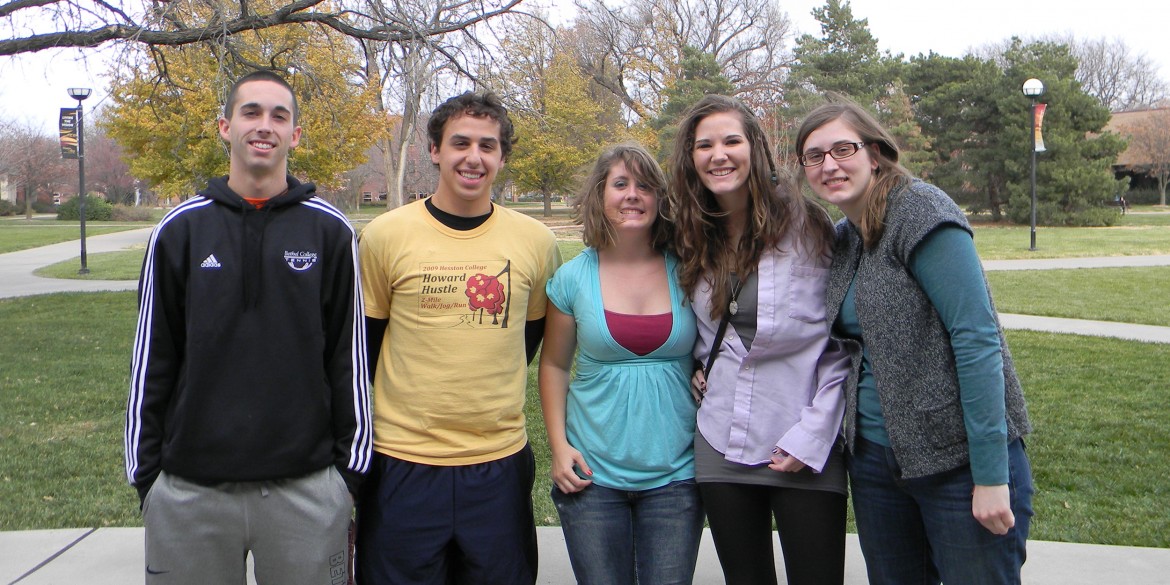“Start Here, Go Everywhere” is more than just a tagline for Hesston College. It is a prediction, a promise and a reality for the students who make Hesston their starting place.
Students scatter across the globe after two years at Hesston. Some accept service assignments while others begin careers with their associate degree in nursing, business, early childhood education, pastoral ministries, aviation and air traffic control. However, the majority of students transfer to another school to finish their education and secure a four-year degree.
For 2011 graduates Chelsey Alden, Santa Fe (N.M.) University of Art and Design; Jenny Carter, University of Missouri – Kansas City; Jennifer Kaberline, Central Christian College (McPherson, Kan.); David Tedone, Bethel College (North Newton, Kan.) and Ryan Wengerd, Goshen (Ind.) College; transferring from Hesston College was a smooth and stress-free experience.
Transferring credit hours, finding a niche and rebuilding a social life at a new place ranked among the students’ top concerns as they thought about the transfer process, but their fears were quickly put to rest.
Hesston administrators and academic advisors make a concerted effort to prepare students with credits that transfer smoothly. Articulation agreements are in place with 11 colleges and universities across the country, including the four other institutions that fall under the Mennonite Church USA umbrella, six local Kansas private institutions and one in Pennsylvania, to make a seamless transition for students.
“We have found most four-year colleges and universities to be very helpful when we inquire with our specific course selection questions,” said Deb Roth, who works with Student Success and coordinates the advising program. “It is helpful to know of a student’s transfer plans as early as possible so advisors can help them make the right choices in terms of general education courses as well as courses specific to their major. Advisors also remind students to contact us when and if a certain course does not seem to transfer easily so the registrar may intervene if necessary.”
For Tedone and Wengerd, articulation agreements between Hesston and their new schools meant all their course credits would transfer with no problem. All of Alden, Carter and Kaberline’s credits transferred with minimal discrepancies as well.
“One of the reasons I chose Bethel was because all of my credits would transfer,” said Tedone.
Besides formal agreements with other institutions, Hesston also works to fully prepare students for their future transfer during their first two years. Academic advising moved to a model that requires first-year students meet with their faculty advisor on a weekly basis for the first eight weeks of class. The intentional arrangement helps the advisor gain a focused picture of the student’s academic and career goals and recommend classes that will be most beneficial upon transferring.
“Academic advisors are continually updating their files of transfer requirements for institutions in which students commonly transfer,” said Roth. “Many departments have done transfer audits as a way to review how Hesston courses are transferring and what additional courses we might offer to prepare students for their next academic steps.”
The students noted that the relationships they built with professors both in and out of the classroom and the educational opportunities offered helped prepare them for the challenges of upper-level undergraduate courses.
“I knew classes that were geared specifically toward my social work major were going to be tough at Bethel and I have been challenged,” said Tedone. “But I had challenging classes at Hesston that prepared me and gave me confidence to move into my major.”
“Hesston has well rounded classes and educational experiences,” said Alden. “My professors helped me line up an internship with the Wichita (Kan.) Public Library as an editor for their news column the summer after my freshman year. That experience allowed me to move directly into more advanced classes at Santa Fe.”
Of course, adjusting to a new environment means hurdles to overcome and anxiety that comes with leaving behind friends and familiarity. While they acknowledge moments of uncertainty, the students found that a little effort can go a long way.
“I wasn’t worried about transferring,” said Wengerd. “I already knew people at Goshen and other Hesston College students transfered there with me. After about a week I realized I was going to have to put forth an effort if I wanted to get to know new people as well. I just kept getting out of my apartment and meeting people. It’s been a great experience.”
“UMKC is a totally different environment than Hesston,” said Carter. “I live in campus apartments, but getting to know people is difficult – it’s just hard to know where to start. Hesston’s small population and the way they do community makes meeting people so natural and simple.”
The students anticipated differences in their new communities, and being prepared for something new helped to ease the transition.
“Santa Fe doesn’t have the same relational atmosphere that Hesston does,” said Alden. “The professors are quick to help, but in most cases, it is more of a strictly business approach. I miss the friendships I had with many of my professors at Hesston, but I am also happy where I am. I identify with the students, and it’s a great fit for me to pursue my passion of creative writing.”
Even though they can no longer claim Hesston as their “home away from home,” the students maintain a connection – both physical and emotional – with the place that started them on their future paths. They stay in touch with classmates, dorm friends, teammates, faculty and staff to remember the community they built in south-central Kansas.
“I miss being able to drop into my professors’ offices to talk about problems and celebrate triumphs,” said Kaberline. “When I come back to visit, people still stop to talk and it’s kind of like I never left.”


